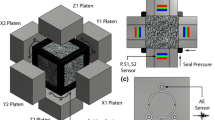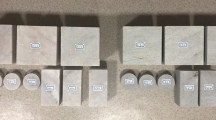Abstract
Two sets of uniaxial compression tests were conducted on a brittle sandstone under a constant circumferential strain rate (2 × 10−6 s−1) and a constant axial strain rate (2.5 × 10−6 s−1), respectively. A combination of active and passive ultrasonic techniques was implemented to study the effect of the control method on mechanical deformation, ultrasonic P-wave velocity, acoustic emission (AE) characteristics, and the ultrasonic amplitude spectrum. During each test, active surveys were performed at regular time intervals. P-wave velocity was found to be strongly anisotropic and was used for the construction of a time-dependent transversely isotropic velocity model for each specimen. AE data were continuously acquired and digitized at 10 MHz and 16-bits for the duration of each test where four channels were amplified 30 dB and the rest 50 dB. Discrete AE events were harvested from the continuous waveforms and were then used for source location analysis based on the constructed velocity model and the collapsing grid search routine. An analysis of the ultrasonic amplitude spectrum was also performed to relate attenuation to the formation of macroscopic fracture. In addition, the post-peak energy balance was quantitatively estimated by calculating the rupture energy, surplus energy, and residual elastic energy, suggesting a typical self-sustaining failure. Differences in the post-peak energy balance between the two sets of tests are also reflected in the AE magnitude distribution in addition to the failure modes. Finally, the reason for the large amount of missing AE data associated with eventual rupture was investigated, with the conclusion that multiple gain levels should be adopted during brittle failure of rocks.
















Similar content being viewed by others
Abbreviations
- W e :
-
Elastic energy accumulated in the specimen
- dW r :
-
Rupture energy in the post-peak stage
- dW s :
-
Surplus energy in the post-peak stage
- \({V_{\hbox{max} }}\) :
-
Maximum P-wave velocity
- \({V_{\hbox{min} }}\) :
-
Minimum P-wave velocity
- \({E_{{\text{RMS}}}}\) :
-
Root mean square (RMS) location error
- \({V_{{\text{P-}}{\mathbf{r}}}}\) :
-
P-wave velocity along the raypath \({\mathbf{r}}\)
- \({N^P}\) :
-
Number of P-wave arrivals in each survey
- \(\Delta {T_i}\) :
-
Difference between the measured and theoretical arrival time
- \({\sigma _{{\text{cc}}}}\) :
-
Crack closure stress
- \({\sigma _{{\text{ci}}}}\) :
-
Crack initiation stress
- \({\sigma _{{\text{cd}}}}\) :
-
Crack damage stress
- \({\sigma _p}\) :
-
Peak stress
- K1 :
-
Brittleness index
- N :
-
Cumulative number of AE events with magnitude greater than ML
- M L :
-
Location magnitude
- \({d_i}\) :
-
Distance between sensor i and the source location
- \({W_{{\text{RMSi}}}}\) :
-
Root mean square (RMS) waveform amplitude of the ith sensor
- \({W_j}\) :
-
Jth sampling point of waveform amplitude
References
Bieniawski ZT (1967a) Mechanism of brittle fracture of rock: part I—theory of the fracture process. Int J Rock Mech Min Sci Geomech Abstr 1976:395–406
Bieniawski ZT (1967b) Mechanism of brittle fracture of rock: part II—experimental studies. Int J Rock Mech Min Sci Geomech Abstr 1976:407–423
Bieniawski ZT, Bernede MJ (1979) Suggested methods for determining the uniaxial compressive strength and deformability of rock materials: Part 1. Suggested method for determination of the uniaxial compressive strength of rock materials. Int J Rock Mech Min Sci Geomech Abstr 16:138–140
Brace WF, Paulding BW Jr, Scholz CH (1966) Dilatancy in the fracture of crystalline rocks. J Geophys Res 71:3939–3953
Cai M, Kaiser PK, Tasaka Y, Maejima T, Morioka H, Minami M (2004) Generalized crack initiation and crack damage stress thresholds of brittle rock masses near underground excavations. Int J Rock Mech Min 41:833–847
Chow TM, Meglis IL, Young RP (1995) Progressive microcrack development in tests on Lac du Bonnet granite—II. Ultrasonic tomographic imaging. Int J Rock Mech Min Sci Geomech Abstr 1995:751–761
Eberhardt E, Stead D, Stimpson B, Read RS (1998) Identifying crack initiation and propagation thresholds in brittle rock. Can Geotech J 35:222–233
Fairhurst CE, Hudson JA (1999) Draft ISRM suggested method for the complete stress-strain curve for intact rock in uniaxial compression. Int J Rock Mech Min 36:279–289
Falls SD (1995) Ultrasonic imaging and acoustic emission studies of microcrack development in Lac du Bonnet granite. Queen's University, Kingston, Ontario, Canada
Goodfellow SD, Flynn JW, Reyes-Montes JM, Nasseri M, Young RP (2014) Acquisition of complete acoustic emission amplitude records during rock fracture experiments. J Acoust Emiss 32:1–11
Goodfellow SD, Tisato N, Ghofranitabari M, Nasseri MHB, Young RP (2015) Attenuation properties of Fontainebleau sandstone during true-triaxial deformation using active and passive ultrasonics. Rock Mech Rock Eng 48:2551–2566
Gutenberg G, Richter CF (1950) Seismicity of the earth and associated phenomena, Howard Tatel. J Geophys Res 55:97–98
Hudson JA, Brown ET, Fairhurst C (1971) Optimizing the control of rock failure in servo-controlled laboratory tests. Rock Mech 3:217–224
Hudson JA, Crouch SL, Fairhurst C (1972) Soft, stiff and servo-controlled testing machines: a review with reference to rock failure. Eng Geol 6:155–189
Lajtai EZ (1974) Brittle fracture in compression. Int J Fract 10:525–536
Lockner DA, Byerlee JD (1992) Fault growth and acoustic emissions in confined granite. Appl Mech Rev 45:S165–S173
Lockner D, Byerlee JD, Kuksenko V, Ponomarev A, Sidorin A (1991) Quasi–static fault growth and shear fracture energy in granite. Nature 350:39
Martin CD, Chandler NA (1994) The progressive fracture of Lac du Bonnet granite. In Int J Rock Mech Min Sci Geomech Abstr 1994:643–659
McGarr A (1997) A mechanism for high wall-rock velocities in rockbursts. Pure Appl Geophys 150:381–391
Munoz H, Taheri A (2017a) Specimen aspect ratio and progressive field strain development of sandstone under uniaxial compression by three-dimensional digital image correlation. J Rock Mech Geotech Eng 9:599–610
Munoz H, Taheri A (2017b) Local damage and progressive localisation in porous sandstone during cyclic loading. Rock Mech Rock Eng 50:3253–3259
Munoz H, Taheri A, Chanda EK (2016a) Rock drilling performance evaluation by an energy dissipation based rock brittleness index. Rock Mech Rock Eng 49:3343–3355
Munoz H, Taheri A, Chanda EK (2016b) Fracture energy-based brittleness index development and brittleness quantification by pre-peak strength parameters in rock uniaxial compression. Rock Mech Rock Eng 49:4587–4606
Nicksiar M, Martin CD (2012) Evaluation of methods for determining crack initiation in compression tests on low-porosity rocks. Rock Mech Rock Eng 45:607–617
Nishizawa O, Onai K, Kusunose K (1984) Hypocenter distribution and focal mechanism of AE events during two stress stage creep in Yugawara andesite. Pure Appl Geophys 122:36–52
Okubo S, Nishimatsu Y (1985) Uniaxial compression testing using a linear combination of stress and strain as the control variable. Int J Rock Mech Min Sci Geomech Abstr 1985:323–330
Paterson MS, Wong T (2005) Experimental rock deformation—the brittle field. Springer, Berlin
Peng J, Cai M, Rong G, Zhou CB, Zhao XG (2015) Crack closure stress and its use for assessing stress-induced microcrack damage. Chin J Rock Mech Eng
Pettitt WS (1998) Acoustic emission source studies of microcracking in rock. University of Keele, Keele
Pettitt S, Baker C, Young RP, Dahlström L, Ramqvist G (2002) The assessment of damage around critical engineering structures using induced seismicity and ultrasonic techniques. Pure Appl Geophys 159:179–195
Rudnicki JW, Rice JR (1975) Conditions for the localization of deformation in pressure-sensitive dilatant materials. J Mech Phys Solids 23:371–394
Sano O, Terada M, Ehara S (1982) A study on the time-dependent microfracturing and strength of Oshima granite. Tectonophysics 84:343–362
Schubnel A, Thompson BD, Fortin J, Guéguen Y, Young RP (2007) Fluid-induced rupture experiment on Fontainebleau sandstone: premonitory activity, rupture propagation, and aftershocks. Geophys Res Lett 2007:34
Shi L, Li X, Bing B, Wang A, Zeng Z, He H (2017) A Mogi-type true triaxial testing apparatus for rocks with two moveable frames in horizontal layout for providing orthogonal loads. Geotech Test J 40:542–558
Sondergeld CH, Estey LH (1981) Acoustic emission study of microfracturing during the cyclic loading of Westerly granite. J Geophys Res Solid Earth 86:2915–2924
Tarasov B, Potvin Y (2013) Universal criteria for rock brittleness estimation under triaxial compression. Int J Rock Mech Min 59:57–69
Tarasov BG, Randolph MF (2011) Superbrittleness of rocks and earthquake activity. Int J Rock Mech Min 48:888–898
Tarasov BG, Stacey TR (2017) Features of the energy balance and fragmentation mechanisms at spontaneous failure of Class I and Class II rocks. Rock Mech Rock Eng 50:2563–2584
Terada M, Yanagidani T, Ehara S (1984) AE rate controlled compression test of rocks. 3rd conference on acoustic emission/microseismic activity in geological structures and materials, pp 159–171
Thompson BD, Young RP, Lockner DA (2006) Fracture in Westerly granite under AE feedback and constant strain rate loading: nucleation, quasi–static propagation, and the transition to unstable fracture propagation. Pure Appl Geophys 163:995–1019
Wawersik WR, Fairhurst C (1970) A study of brittle rock fracture in laboratory compression experiments. Int J Rock Mech Min Sci Geomech Abstr 1976:561–575
Weeks J, Lockner D, Byerlee J (1978) Change in b-values during movement on cut surfaces in granite. B Seismol Soc Am 68:333–341
Wen T, Tang H, Ma J, Wang Y (2018) Evaluation of methods for determining crack initiation stress under compression. Eng Geol 235:81–97
Yanagidani T, Ehara S, Nishizawa O, Kusunose K, Terada M (1985) Localization of dilatancy in Ohshima granite under constant uniaxial stress. J Geophys Res Solid Earth 90:6840–6858
Zhang SH, Wu SC, Zhang G, Guo P, Chu CQ (2018) Three-dimensional evolution of damage in sandstone Brazilian discs by the concurrent use of active and passive ultrasonic techniques. Acta Geotech. https://doi.org/10.1007/s11440-018-0737-3
Zhao XG, Cai M, Wang J, Ma LK (2013) Damage stress and acoustic emission characteristics of the Beishan granite. Int J Rock Mech Min 2013:258–269
Zhao XG, Cai M, Wang J, Li PF, Ma LK (2015) Objective determination of crack initiation stress of brittle rocks under compression using AE measurement. Rock Mech Rock Eng 48:2473–2484
Acknowledgements
The research is supported by the National Natural Science Foundation of China (51774020) and the Beijing Training Project for the Leading Talent in S & T (Z151100000315014). The authors thank Zhengjun Huang for his kind help with the uniaxial compression tests and Dr. Kang Duan for his helpful discussion.
Author information
Authors and Affiliations
Corresponding author
Additional information
Publisher’s Note
Springer Nature remains neutral with regard to jurisdictional claims in published maps and institutional affiliations.
Rights and permissions
About this article
Cite this article
Zhang, S., Wu, S., Chu, C. et al. Acoustic Emission Associated with Self-Sustaining Failure in Low-Porosity Sandstone Under Uniaxial Compression. Rock Mech Rock Eng 52, 2067–2085 (2019). https://doi.org/10.1007/s00603-018-1686-8
Received:
Accepted:
Published:
Issue Date:
DOI: https://doi.org/10.1007/s00603-018-1686-8




